Kristene Perron's Blog
February 1, 2019
The End – Keepers

We’veall had phases in our lives that have had to come to an end. That’s how ourlives work. We grow, we move on. Besides the lessons I’ve learned in those lifephases, the most valuable thing to come out of those endings, are the people I’vepicked up along the way.
Friendshipis a bit like fishing. Some people we catch and we keep. Other times, it’scatch and release. When a phase in your life ends, it can mean saying good-byeto some friends and letting them go. This isn’t always easy, but usually inhindsight, we can see it was appropriate. The ones that are special, though,the keepers, are the ones you end up taking home, cleaning, filleting andeating or putting in the freezer. What?
PerhapsI took the fishing metaphor a little too far there, but you get the idea. Somefriends stay fresh, with you throughout your different phases, regardless ofthe ending or the new beginning. Somemay get frozen for a time, but you can always count on them to thaw out andstill be delicious. Too far again?
Howdo you know which friends are the keepers? Sometimes you don’t have a choice.Sometimes when a phase of your life ends, so does that friendship. It can endbecause you’ve moved on, or they have. It can end simply because interests havenow changed or you don’t mean as much to them anymore once you’ve moved on. Inthat case, a release of that friendship is best for everyone.
Thosewho end up as keepers are the ones who stick with you through the endings andcheer you on to new beginnings. It’s a filtering process, perhaps nature’s wayof letting only the best survive in your life. The ones you know you can keep,cook and eat, or, not. Whichever. One things is for sure, you will value theirfriendship all the more. Endingshappen to keep us moving. One thing ends and we move on to the next, sometimeswhether we want to or not. In the Return of the King, Frodo said, “I’m glad tobe with you, Samwise Gamgee, here at the end of all things.” I am glad forendings. I am glad to have had the many different phases in my life and thefriends I’ve caught along the way. To all of my keepers, I thank you. I will beglad to be with you, at the end of all things.
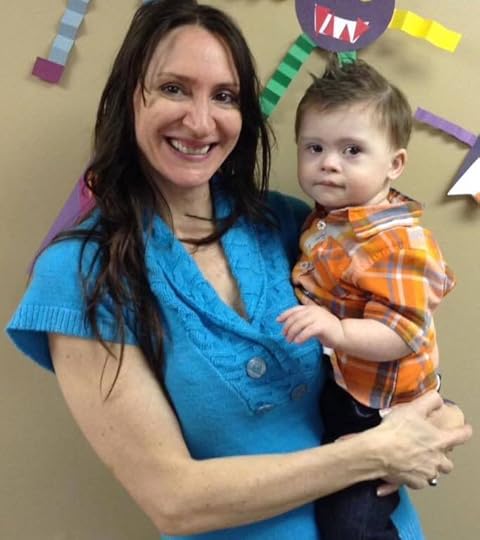 Author and Creative Ink Festival Goddess, Sandra Wickham with her son, Ben.
Author and Creative Ink Festival Goddess, Sandra Wickham with her son, Ben. Sandra Wickham lives in Vancouver, Canada with her husband and toddler son. Her friends call her a needle crafting aficionado, health guru and ninja-in-training. Sandra’s short stories have appeared in Sirens, Equus, The Urban Green Man, Evolve, Vampires of the New Undead, Crossed Genres magazine, Luna Station Quarterly and more. She slush reads for Lightspeed Magazine and promotes the Creative Ink Festival for writers and readers.
January 27, 2019
The End – Writer’s Grief
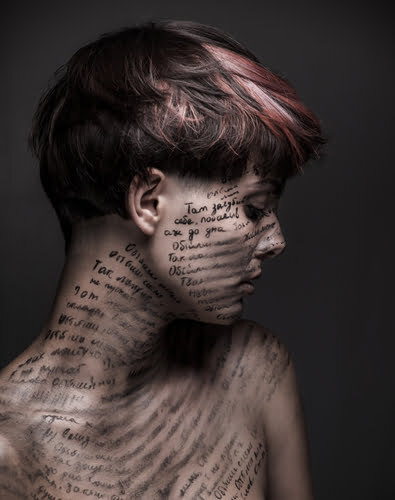
You’ve written those two lovely words: the end. For somewriters, the time is one of celebration—look at what I’ve accomplished! Ifinished my book! You know only ten percent of writers who begin a book finishit, right? It’s time for the Snoopy happy dance!
But … what if it’s not?
What if, instead of feeling like celebrating, you feel sad?If you do, there’s absolutely nothing wrong with you. I want to state that upfront. Unequivocally. For those of you who don’t, let’s take some time toexercise that vaunted writer’s empathy, and see if we can’t relate to ourfellow creators.
Whether you’ve written a short story or an epic series,you’ve spent days, weeks, or even years with these characters living in yourhead. You’ve gotten to know them, probably to love them. You’ve learned abouttheir world, even if it’s one you created. You know so many intimate detailsabout that world that will never be shared with a reader.
And now, it’s time to say goodbye to all of that. The end.
For some writers, those two words represent a death thatmust be grieved. For others, it can start a period of darkness not unlikedepression. In either case, there may be a period of time during which thewriter cannot create, either because they’ve yet to process their grief, orbecause they are legitimately depressed.
While much has been written about Kübler Ross and Kessler’s fivestages of grief (denial, anger, bargaining, depression, and acceptance), it hasalso been suggested that grief isn’t as simple a process as the model wouldhave us believe. Grief defies being corralled into stages with definedtimeframes that flow one into another. In truth, the griever can move betweenany of the stages, in any order, staying in each for an undetermined period oftime. They can even get “stuck,” swinging between two or three of the stages ina negative feedback spiral, never reaching acceptance.
The truth is, grief takes the time it takes. You have to letyourself experience it, to grok the fullness of it, if that’s your thing. Thewriting will still be there when you’ve worked through your grief. A new ideawill streak through your mind like a comet, and you’ll know it’s time to getback to the page.
If you find yourself, after the period of protractedcreativity that is writing, feeling listless, exhausted, unwilling to get outof bed, or not enjoying the things (like writing) that usually bring you joy,you may be depressed. Unlike grief, the depression may not be triggered byloss. It may simply be that you’ve spent too long working too hard on yourproject and not ensuring that you’re getting enough self-care in the mix.
This post-creation depression can also be recognized asburnout. Again, the key is to be gentle with yourself. Guilt is not going tohelp the situation. It can take some time to regain your usual mood andtemperament.
I also need to caution you at this point that if you thinkyou may be on the side of true depression rather thandepression-as-part-of-the-grief-cycle, that you should be attentive. Talk toyour loved ones. How are they being affected by this change? Do they think itmight be something more serious?
Mental health is a serious matter. If you think the symptomshave gone on too long or they’re beginning to have a negative impact on otheraspects of your life, please see your doctor. There is no shame in it. Therapy,medication, or both could be what you need to right your craft again.
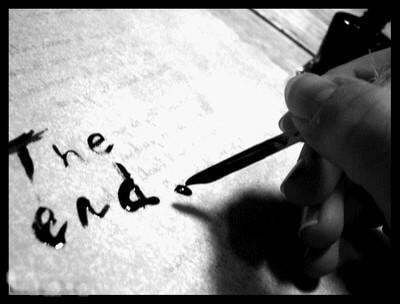
I’m not a doctor or a psychiatrist, but as a writer wholives with depression and anxiety, I can only recommend that you seekprofessional assistance if you suspect your depression may be of the clinicalvariety. It’s better to know than to let it go, untreated.
Writing “the end” doesn’t have to mean the end of yourcreative life. It may just mean that you have to take some time to honor thework you’ve produced, the time and effort you invested in its production, andlay it to rest so that you can make room in your heart and mind for the next,wonderful story you’re going to write. And you are going to write again. I havefaith in you.
And … if the work you grieve was a single story or novel,you may find, in your time of gentle reflection, that the story is not yetcomplete, “the end” be damned. Maybe it’s time to write a series!
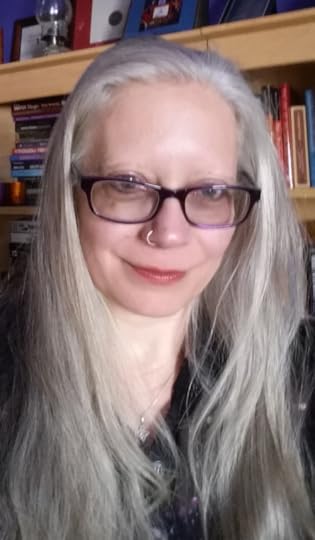
Melanie Marttila is a certified corporate trainer by day and science fiction and fantasy writer by night. She writes the DIY MFA column Speculations, which is about all things SFnal. Her short fiction has appeared in Bastion Science Fiction Magazine, On Spec Magazine, and Sudbury Ink.
You can find Melanie online at her blog, Writerly Goodness, on Facebook or Twitter.
January 24, 2019
The End – Ending a Campaign
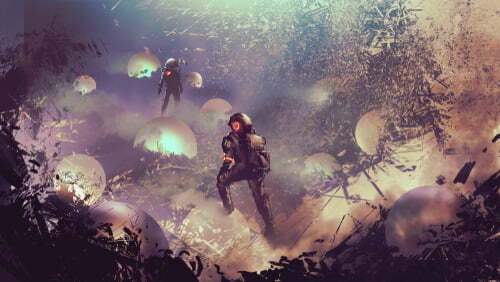
Hello, my name isCameron, and I play Tabletop or “Pen and Paper” Roleplaying Games like Dungeonsand Dragons or Vampire the Masquerade. For those of you who might not know,these sorts of games are played with a group of people who sit down to tell acollaborative story wherein one person generally sets the stage with the world,the conflicts, and the supporting cast and antagonists. The other people aregenerally playing major characters within that story, and attempt to resolvethe various conflicts. Resolving the conflicts is done by way of various agreedupon rules, often involving dice, cards, or other elements of chance, or someform of narrative negotiation.
These games are played in regular intervals called “sessions”, lasting between three to six hours on average involving usually around a half dozen people or so, meeting on weekly or monthly schedules, as time allows. Completed stories are called “campaigns”, while major narrative arcs are called “adventures”. Completed stories are rare, because these stories take months or years to tell, and groups often do not last that long because life can get in the way. However, when one does get a chance to complete a campaign, it is usually a story to remember.
In my many years of playing and running these games, I have only ever completed three full campaigns. I have done dozens, if not hundreds of single session introductory games at conventions, many of which went quite well, some of which went poorly, and a few of which were fantastic. My first real attempt at running a game was one. It was during my college years and during a summer break. Two close friends, and the brother and friend of one of those friends came to my parent’s place and I ran them through a published campaign book. It was a lesser known science-fiction game set on a far-off world rife with politics, action, and remains to this day one of my favorite fictional worlds to play in.
Now, published adventures and campaign books are materials one uses to run a game that provides the person running the game with the story and conflicts already created and ready to go. Some are more rigid, others are more flexible. This one provided not just the structure I needed as a novice to get started, but advice and suggestions for ways to expand on it that would lead to me building my own stories. Not just that, but suggestions for things to help the players add to the story as well. Early on, I stuck to the script provided while I got used to running the game. But as the game went on, as the players added more and more of their own story to the game, the more I changed, removed, or added from what was in the book to adjust.
When the final game was upon us, we were already down one player due to real life concerns. The player had a scheduled trip with their family, so it was just myself and the remaining three players. We were a week or two from the end of summer break, and it was a bit after midnight. We had been playing for nearly twelve hours, as we were on summer break, and we were very much excited to keep playing. I looked at the rest of the book and my notes, looked to the players, and informed them that we had a choice. We could stop here and finish up next week, or we could push through and finish it before everyone had to go home the next day.
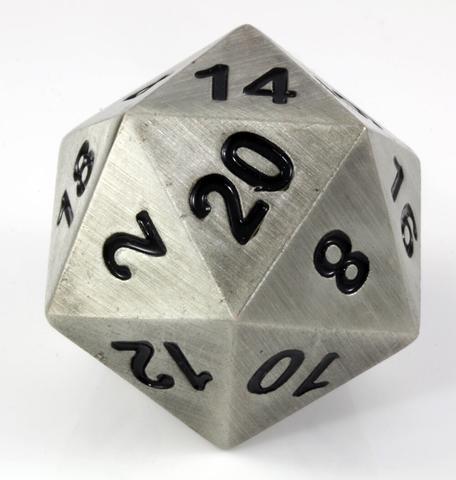
So, like many college students with access to caffeine and junk food, we pressed on. When we had finished, we had been playing for about 26 hours, and the characters had been through a similar gauntlet, staying up for 38 hours. When they had taken stimulants to keep going, we had downed cola. When they took painkillers to push themselves further, we stretched and grabbed a handful of chips. The final scene was one that just worked. The dialog, the dice, everything. The players finished the game feeling exhausted on not just a physical but also an emotional level, but at the same time satisfied.
Even now, I still remember that campaign fondly. I have written short fiction for it, as have some of the players. I even had one of the final moments drawn by a very talented artist. We even tried to run a sequel. It was my first solo campaign. I had tons of great ideas, we were going to have the entire team back, we even had a new player.
The game lasted about three sessions before it just fell apart. It was not working well, and the usual scheduling conflicts helped to end things before people started souring on it altogether.
That is the thing, getting to these endings is hard. When you create it yourself, you have to plot everything, then adjust for all the things the players add, your own diversions, the sessions where characters are shopping or the players are socializing instead of playing the game, and that is when you can actually get everyone together. When you can do it though, it is wonderful, and even though I was using a published campaign book, the story of that game is going to be fundamentally different from any other game that used that book, on a number of levels. Sure, the major events will be the same, but the main characters will all be different, as will their actions, as will the results of their actions. If my players ran that same game with someone who was not me, it would not have ended the same way. If they had played with me and some dice results had gone differently, they might have prematurely ended the threat of the main antagonist. Each campaign, even if many elements are the same, are fundamentally different stories.
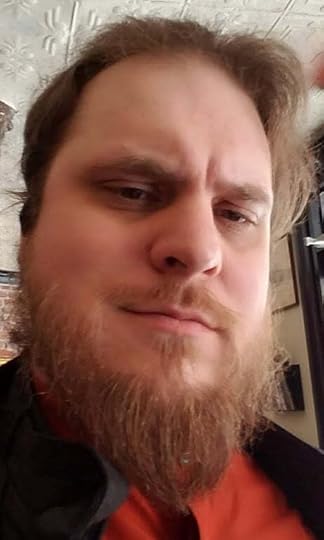 Game Master and General Purpose Nerd Cameron Johnson
Game Master and General Purpose Nerd Cameron JohnsonCameron Johnson is a Game Master, LARPer, and general purpose nerd. He does amateur voicework from time to time and spends far too much time pretending to fly around the galaxy. Every week or so he manages the misadventures of a group of reprobates that includes Joshua Simpson. Despite this, he was still willing to write this article.
January 22, 2019
The End – Ending and Beginning
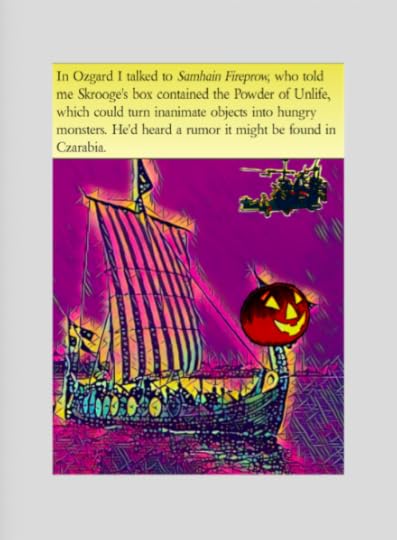
A beginning is an ending, always.
That quote is from the short story Satan’s Children, by Spider Robinson. It is, in fact, the very first line, and possibly the best first line ever written. I mention this because I got to tell Spider that, the very first time we met, and that was the beginning of a thirty-year (so far) friendship.
I love that line, not just for its elegance, but for the sheer truth of it. The thing is, there’s often a transition period between the two states when pain makes it hard to tell much of anything. Birth and death both hurt like hell.
So. Beginnings, and endings.
Two and a half years or so ago, my marriage ended. Nobody cheated, there was no abuse of any kind–it mostly had to do with my fibromyalgia getting worse, and making me hard to live with as a result. There was other stuff–there always is–but ultimately the bond between us just wasn’t strong enough to take the strain of the forces pulling us apart. The marriage came to an end, as they sometimes do.
I’ve had relationships end before. This was different. We’d been together longer than either of us had previously experienced. We had a home. We had a child. We had a life.
And it ended–except it didn’t.
If I could have just walked away and started over, I could have handled it. But you don’t walk away from being a parent, not ever. And my love for my son is bigger than anything, including my own pain.
So I didn’t get a clean ending. I got a long, protracted, messy one. She kept the house. I got memories that ambushed me every time I went there to pick my son up or drop him off. I couldn’t walk down the street where I’d lived, or talk to the neighbours I’d come to know, or visit the restaurant we used to eat in–not without an overwhelming sense of loss. I was trapped in that feeling–an ending that never ended. An amputation is far preferable to slowly having a limb ripped off.
But at the same time I was experiencing that constant ending, I was also beginning.
I’ve been a novelist for most of my life–and while I’ve never gotten rich, I’ve had a decent career. Twenty-four published novels over thirty years, a few short stories, essays and plays, a brief stint as a magazine columnist.
But here’s the thing: did you know Babe Ruth–one of the greatest sluggers in baseball history– wanted to be a pitcher?
I’m no Babe Ruth. But even though I’ve done fairly well as a paperback writer, there’s something else I’ve always wanted to do: comics. Even managed to sell a few scripts to Marvel back in the nineties, just before the big crash in the comics market. The line I was writing for–a cyberpunk version of superheroes–died. I still got paid, but my work never saw print.
I tried to break back into the market for years, but never managed it. I eventually gave up, realizing that the comics world was too competitive, too corporate, and too cliquey for me. I made my peace with it.
But I still wanted to make comics.
Interesting thing about fibromyalgia: one of the symptoms is called “fibro fog”, and it basically destroys your ability to concentrate. When this happened to me, I couldn’t write. For my entire career, I’d prided myself on never missing a deadline; I used to be able to write a 100,000 word book in four months and I was never late.
That streak ended when my fibro worsened. My last book was months overdue, and I was forced to stop work on the one after that only a few chapters in.
But I’d come up with an idea a few years before, one I’d never had time to work on before. While constantly exhausted and spending most of my time in bed, I discovered that I still had enough brain-power left to surf the web and do some research. Maybe I couldn’t string words together into coherent sentences anymore, but my imagination still worked.
And slowly, over many months, I figured out how I could make a webcomic. While large parts of my life were about to end, here was a beginning.
To make a comic, you need to have someone to write it and someone to draw it. These can be the same person, but I have zero drawing ability. I had to rely on collaborating with other artists, and that was one of the bottlenecks that make breaking into comics really difficult. You have to find someone willing to work with you with zero money upfront, on projects that will require a sizeable time commitment on their part–art takes a long time to do and a huge amount of work. Plus, you have to find someone whose stuff meets the standards of high-quality work already being published, but who hasn’t broken in yet themselves–because as soon as they do, they’re swamped with paying work and you no longer have a collaborator. A tricky needle to thread.
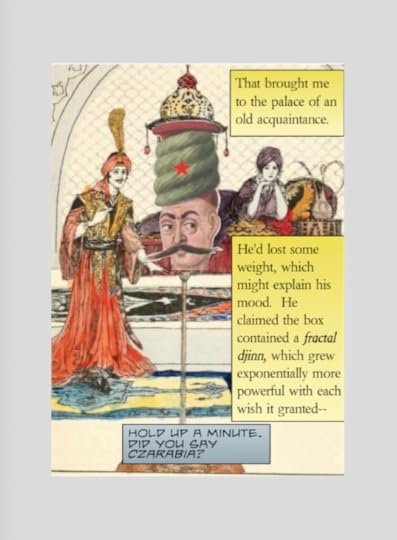
So I made myself into something new: an artist.
Technology made it all possible. Apps that adapt pictures into comic-book format. Filters that transform photos into art. And a wealth of public-domain online imagery, from Creative Commons photos to museum, art gallery and library archives all over the world that made their content freely available to anyone to use, alter, or sell.
I’m more of a DJ than a musician, but I’m okay with that. And I discovered that manipulating images uses a different part of my brain, one that requires less focus and more repetitive tasking. It’s still time-consuming, but far less so than drawing would be.
And it’s all under my control. Which, when you find yourself trapped in a situation that makes you feel powerless, is a life-saver.
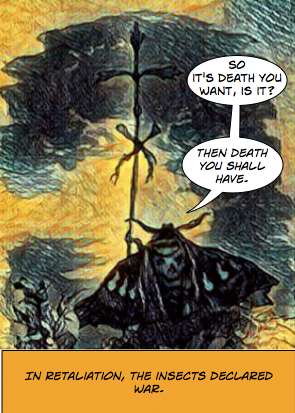
My webcomic is called THE CROSSOVER. It’s set in a multiversal bar where fugitives, mercenaries, smugglers and thieves meet on neutral ground to make deals. My heroine is a version of Alice, one who grew up to become a universe-hopping sorceress who specializes in stealing artificts–items from alternate fictional realities.
Almost anyone, from any universe, can show up in the Crossover bar. I’m using not just public domain art, but images of cool stuff other artists have made–stuffies, jewelry, costumes–and putting up links to their pages below the comic panel so I can promote their creations at the same time. All done with their permission, of course, and they retain all rights. If you’ve got something neat you’d like to show off, let me take a pic of it and stick it in my comic. Heck, you can even have one of your characters drop by for a drink. And if you’re a Spider Robinson fan–like me!–I have it on good authority that a certain Mike Callahan sometimes tends bar there, as a favor to an old friend.
Oh, and Spider’s story Satan’s Children also gets my vote for best final line, too:
An ending is a beginning, always.
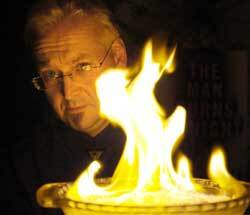
DD writes under four different pseudonyms. As Don DeBrandt he’s written several science fictions novels (THE QUICKSILVER SCREEN, STEELDRIVER, TIMBERJAK, V.I.,) numerous pop-culture essays for Smartpop Books, and the Buffyverse media tie-in SHAKEDOWN (an ANGEL novel).
As Donn Cortez he’s written five CSI: Miami novels, two CSI: Vegas novels, a murder mystery set at Burning Man (THE MAN BURNS TONIGHT) and a thriller (THE CLOSER) which became a bestseller in Germany. (The sequel, REMOTE, is available as an e-book in English).
As DD Barant he’s best known for his Bloodhound Files series: DYING BITES, DEATH BLOWS, KILLING ROCKS, BETTER OFF UNDEAD, BACK FROM THE UNDEAD and UNDEAD TO THE WORLD. As Dixie Lyle, he’s written the Whiskey, Tango and Foxtrot Mysteries: TO DIE FUR, A TASTE FUR MURDER, MARKED FUR MURDER and A DEADLY TAIL.
You can learn more about DD and his art at his comic series The Crossover, on his website DDBarant.com, on Twitter, and on The Officialicious DDBarant Facebook Page.
January 21, 2019
The End – The Unexpected Gift
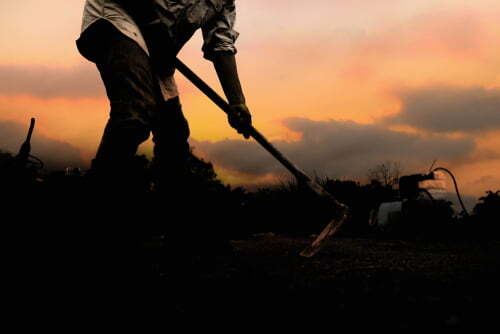
I remember exactly where I was when I gotthe news my older brother Doug had died. It was the Monday of Labor Dayweekend, 2011. I was at my home, a 28-acre forested property in MulmurTownship, southeast of Collingwood.
The telephone rang, and I answered. It wasmy eldest brother Peter calling to tell me Doug had passed away earlier thatmorning.
The news both did, and did not, come as ashock. After having a stroke-like memory loss one August day in 2010, Dougspent some time in the hospital before being diagnosed with an aggressive formof brain cancer. Chemotherapy beat back the disease for a bit, but his healthbegan to decline again, leading ultimately to a stay in a hospice before theday of the fateful call.
So the call was not unexpected—and yet,the final confirmation of what we dread is always, in its own way, an unwelcomesort of thing.
What made Doug’s death sting all the more washis age—he was only 58, and that seemed much too young.
Doug was six years older than me. Losinghim really made me think about my health and my future, and became one of themotivators—although not the only one—that drove me, three years later, to take earlyretirement at age 55.
Doug, on the other hand, had opted tocontinue working, although he too could have taken early retirement, albeitwith a reduced pension. As his health declined, I fretted that he’d made thewrong decision. Doug owned a large rural property, and had harboured thoughtsof spending his retirement days puttering around doing this and that. It struckme as unfair that he never got the chance.
I remembered so many family Christmasget-togethers where he’d either been absent, or been there on loan, his pagerclipped to his waistband as though he were some sort of corporate gun-slingerready to take on trouble at the drop of a hat. He worked too hard, I told myself. He never got the chance to really enjoy life.
A heart-warming number of Doug’s friends,fellow nature enthusiasts, former fastball teammates, and co-workers showed upto the visitation, the memorial service, and the Celebration of Life afterwardin the local Legion hall. As they made my way to the line in the visitation, orstopped and chatted with me in the quiet confines of the Legion hall, theattendees offered condolences and often, a shared story or two. It was theanecdotes, particularly those shared by co-workers, that lifted my spirits alittle.
The stories shared by his co-workers clearlyillustrated that Doug was one of those fortunate people who truly loved his job.They spoke affectionately of him as their “big brain”, thequintessential problem solver. They shared stories of his mentorship, hisdedication to the job, and his forthright but fair way of dealing with peopleat all levels in the organization. They talked about the enjoyment he got fromwrestling a thorny problem to the ground.
Some of the anecdotes were simple, somealmost trivial—yet individually and as a whole they provided comfort. Therespect and affection with which Doug’s co-workers spoke of my brother told methat he’d had a second “family” away from home—one that had careddeeply for him, and looked out after his interests.
It seems such a small gesture on theirpart, to come to a visitation and memorial service and exchange words with thefamily, yet these insights were inestimably valuable to me. Those comments andshared stories proved to be an unexpected gift that moved me closer toaccepting my brother’s fate, bridging a gap I likely wouldn’t have been able tospan on my own.
I got to thinking that maybe, in his ownway, Doug would have preferred to go out at the top of his game, rather thanfading off into the sunset. Perhaps retiring would have left a void in hislife—who was I to say? Either way, I now realized I had neither the right northe responsibility to pass judgement on his choices. Finally, I found myselfable to let go of the bitterness I’d felt on his behalf.
It’s been just over seven years since Dougpassed away, yet I still find myself thinking of him often. I miss his quirkysense of humour, his ability to reel off abstract facts, and the deep enthusiasmhe radiated when talking about his favorite pastimes and interests.
And yet, I also realize that he lived lifeon his own terms. Sure, he never got to retire. But he worked at a challengingjob that he deeply enjoyed, and in that much, he was a lucky guy.
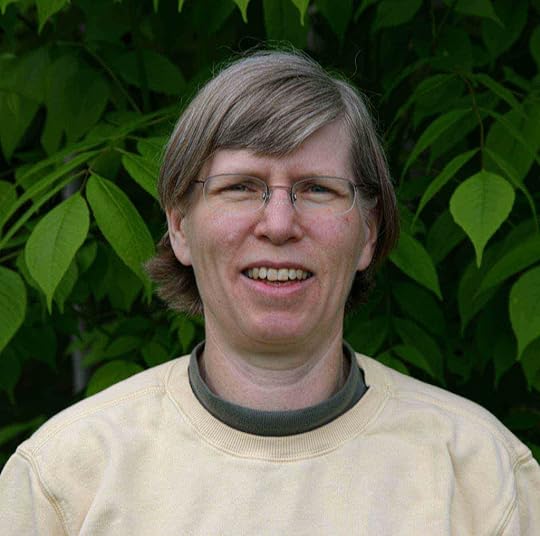 Author Lisa Timpf
Author Lisa TimpfLisa Timpf is a retired HR and communications professional who lives in Simcoe, Ontario. Her writing has appeared in a variety of venues, including four Chicken Soup for the Soul anthologies, Small Farm Canada, Star*Line, Dogs of War, and The Future Fire. She has self-published a collection of creative non-fiction and poetry entitled A Trail that Twines: Reflections on Life and Nature, and also wrote St. George’s Lawn Tennis Club: The First Hundred Years, the history of a tennis club in Dartmouth, Nova Scotia
You can learn more about Lisa at her blog The Writing Journey, on Amazon, or Goodreads.
January 18, 2019
The End – A Conversation With Joshua Simpson & Kristene Perron
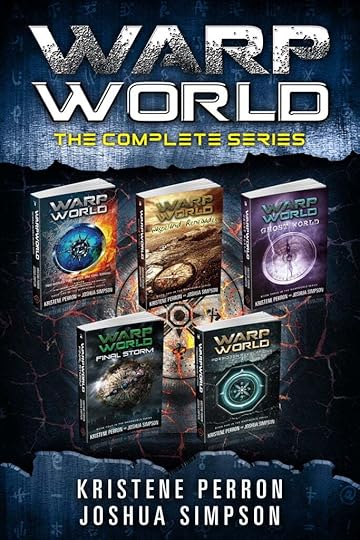
***SPOILER ALERT AHEAD! (For Warpworld books 1 through 4)***
As we prepare to send the final chapter of the Warpworld saga out into the world and launch our final guest blog series on the Warpworld Comms, Josh and I thought it would be fun to share some behind-the scenes talk and photos of our experiences working together for almost ten years.
Kris: First, Josh, holy crap, it’s been almost ten years!
Josh: Yeah, and honestly it does really feel like it, too. But then I’ve been through: the job I had when we first met, going back to college to further my career, changing at the tail-end of my time back in college to an entirely new career, and then working at that long enough to become a known and established figure in my field. So, I really do feel that decade.
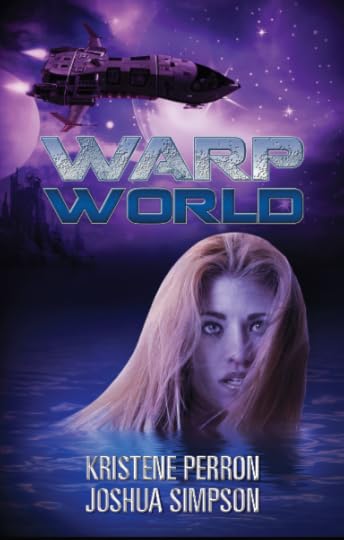 The original version of the Warpworld Vol. 1 cover which we, wisely, decided to toss away and start over! #Amadoesnotwearmakeup
The original version of the Warpworld Vol. 1 cover which we, wisely, decided to toss away and start over! #AmadoesnotwearmakeupKris: My body definitely feels the decade! Ow. This whole crazy adventure started when you asked me about working with you on a story idea you’d come up with. It was just supposed to be a fun little RPG-type of writing game. Did you ever imagine it would morph into five published novels and a couple of published side stories?
Josh: At the time, I felt the idea was the solid foundation of a potential novel, which is why I broached it with you in the first place. Whether or not it turned into a book (or five), I wanted somebody I felt could do justice to what I felt was a solid idea. Boy, did you ever.
 Kris poses in front of the early version of the “Warpworld Inspiration Wall” , Nelson, BC, 2011
Kris poses in front of the early version of the “Warpworld Inspiration Wall” , Nelson, BC, 2011Kris: Lol…I can be enthusiastic when I like something, yes.
Josh: So, we wrote basically a book and a half worth of material before deciding that, yes, something that was eating this much of our lives needed to be put to work. Our first question was where to cut it, and then where do we go from there. At that time, we had a pretty good skeleton outline running ahead to the end of the third book.
Kris: Oh, let’s talk about the third book, Ghost World. **And remember, folks, there will be spoilers for the first four books ahead!** I clearly remember when I suggested, “Hey, let’s split Seg and Ama up for almost the entire book!” You were skeptical, lol.
Josh: I don’t specifically recall that, but it did turn into quite a writing experience. I really felt that Ghost World was where we hit our stride because it was the first manuscript we wrote from beginning to end with the entire intention of making it a book. But before we dive too deeply into that, I want to touch on the second book, Wasteland Renegades a bit.
 The Great Refuge of Masada, one of the inspirational images we used for the Wasteland and Julewa Keep in Wasteland Renegades
The Great Refuge of Masada, one of the inspirational images we used for the Wasteland and Julewa Keep in Wasteland RenegadesFor me it’s kind ofthe sentimental favorite in the series—I love everything about it from thestory, to the cover, to the subtitle. What’s funny about Wasteland Renegades is that we had so little to start with when webegan the second draft rewrite. Because we hadn’t been plotting to write abook, the action flowed very organically from one scene to the next in ourgame, and the climactic battle in WastelandRenegades was essentially just another episode that initially launchedalmost directly from the conclusion of the original novel.
We had to basicallywrite an entirely new story to take us from the ending of Warpworld to the ending of WastelandRenegades, and I felt we did a pretty darn good job.
Kris: Me too! (I am admittedly biased). Wasteland Renegades was where I felt we really got to know our characters, particularly Seg and Ama. I will always think of it as the “honeymoon’s over” book. And that book is also where Fismar took center stage. He’s such a reader favourite. I think we made a few folks unhappy when we killed him.
Josh: Uh, yes. Yes, we did. I hear about it. But there had to be prices paid, there had to be consequences, both external and internal. Fismar’s nature was essentially self-destructive from his earliest scenes, and only his supreme competence kept him alive as long as it did. I liked him as much as anybody and writing that scene was a bit wrenching. But that’s a good thing, in general. If it’s wrenching for you as a writer, it’ll be wrenching for the reader too. Bleed on the page, as Hemingway said.
 Poor Fis…
Poor Fis… 
Kris: Speaking of favourite characters, I know we love all of our dysfunctional imaginary children but do you have any favourites after all this time?
Josh: Moud. For just the pure joy of writing, I love Moud. In the original draft of Ghost World, she was an unnamed throwaway, a voice of conscience that was meant to send Shan back to Julewa Keep.
I have no idea which of us decided that her expanded dialogue in rewrite merited bringing her back to Julewa with Shan, but whoever had the idea ended up making my day more than once because, for whatever reason, I feel like Moud brings out the best of my wit. To this day, my favorite line in the whole series is “I’m too old for this. That’s exactly what they told me, they said ‘Moud, you’re too old for this’ and they gave me a shiny metal bit and a two week pay voucher and—”
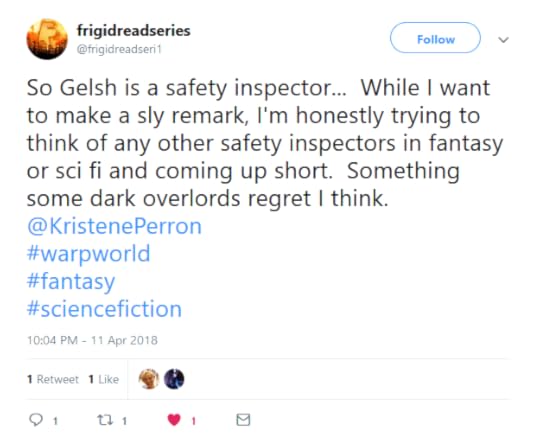 Is Gelsh the first Safety Inspector in SFF?
Is Gelsh the first Safety Inspector in SFF?Gelsh is anotherfavorite, though he probably suffered more than anyone from the rewrites. Hisprominent role in the first draft of ForbiddenRevelations got whittled way back and while he still gets to showcase whatI like about him (his loyalty, his morally upright nature, his wit) it doesn’tmatch up so well as what we had in our original version of the fifthmanuscript.
You?
Kris: Ditto on Moud. No character arc, just sass and crankiness from start to finish. Gelsh for the same reasons as yours—he has so much heart. Shyl is the character who felt most like me as time went on. But Maryel really grew on me the most as the series progressed for a few reasons. First, she’s tough as nails but not inflexible. Second, I loved her relationship with Jarin. She kept him honest (no easy task). Also, it was important to me to show older people who were not just stereotypical Wise Mentors. Maryel was smart, strong, and sexy. We need to see more characters with grey hair and wrinkles that are multidimensional.
Josh: Yeah, the council member bloc (Jarin, Maryel, Shyl and Ansin) were a vibrant part of the story for me. They allowed us to play with the grand level politics on one hand, and have the denizens of Julewa Keep living through the front-line consequences on the other.
If not for Moud, Shylwould have been a favorite. She’s so damn cool, smart and capable andlevel-headed.
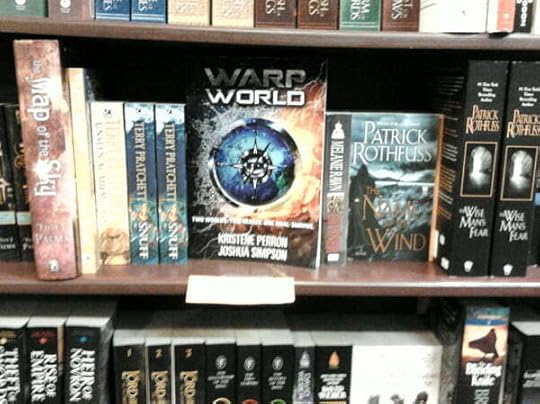 Seeing your book on a shelf (next to Rothfuss and Pratchett, no less)… best feeling ever! Thanks, Otter Books!
Seeing your book on a shelf (next to Rothfuss and Pratchett, no less)… best feeling ever! Thanks, Otter Books!Kris: I’m also very proud of our villains. I have a friend who tells me every time I see her that Lissil MUST die at the end. She is very insistent.
Josh: Oh yes, Lissil is the hall of fame villain in the series, nobody else comes close. I mean the other villains come and go and people don’t mind seeing them die, but they really want to see Lissil go down.
And so of course wechanged our plans from the original outline, where she died in the fourth book,in order to bring her back in the fifth book. See, if you hate her that muchthen we have to keep her around, folks.
Kris: Hee hee. I want to switch gears for just a moment here and talk about real life stuff. Let’s get gritty. You know the question I’ve been asked the most during our entire run on this series is how we work together across the vast distance between wherever I am in the world (usually BC, Canada) and Texas. People are amazed by the technical details but, honestly, I think the human side is the most complex. We were virtually strangers when we started and we’ve spent thousands of hours working and messaging together since then. It hasn’t always been easy, has it?
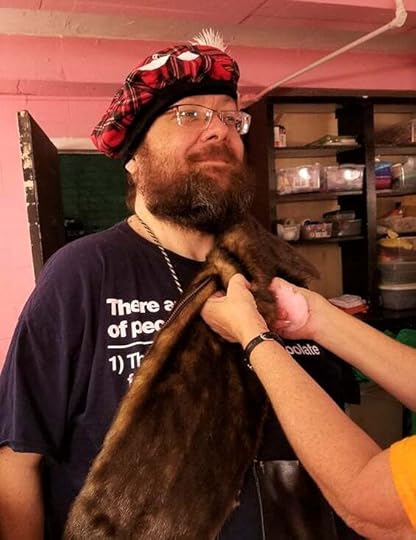 Sometimes Josh was busy being an ACTOR!
Sometimes Josh was busy being an ACTOR! Josh: Oh no, no, it wasn’t always easy. I mean we have a fairly compatible nature between us, so it’s not like it was all havoc and chaos. But there was an adjustment period, compounded by various life stresses we were both going through (moves, job changes, financial issues, college, scheduling difficulties, etc.)
There were mostly good days, a few bad days, and we both had to adjust. I’m me, you’re you, and we had to learn where our middle space was. What really impresses me the most, a thing I noticed with the fourth book and onward, was how well our conflict resolution became honed. Essentially, we can feel going into a disagreement (artistic, business, whatever), who is feeling more solid on the subject. Because I trust you completely, I’m fairly comfortable in going with your gut if I can tell that you’re feeling more strongly about a thing than I am. Our disagreements these days tend to be very functional things—we each make our case, then we go with the stronger gut consensus.
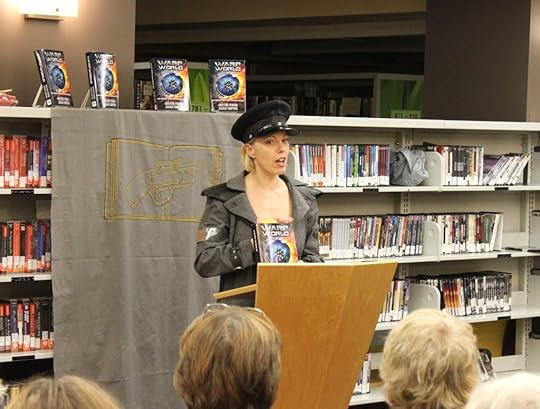 Kris’s first public event: The Warpworld Vol. 1 launch at the Nelson Library, 2012.
Kris’s first public event: The Warpworld Vol. 1 launch at the Nelson Library, 2012.Kris: True. I’ve done some presentations at writing events on co-authoring and I always talk about the importance of the need to be honest and also to keep business and friendship separate. It can be tough. But you were a good yin to my yang. I have a tendency to get really wound up and hyper and worried about everything being perfect, perfect, perfect, which is just plain impossible in storytelling. You helped me relax and enjoy the story. So, thank you!
Josh: And your relentless organization, attention to detail, and methodically rigorous scheduling helped keep me on track. Neither of us knew that we would fit so well together, work-wise, when we started this. One of life’s happy coincidences.
Kris: Awww, yes, sometimes life is kind. So, here we are at the end. I know we’re both looking forward to moving on. As much as we love our imaginary children, ten years is long enough. Any favourite memories or thoughts or words to our readers as we wind down?
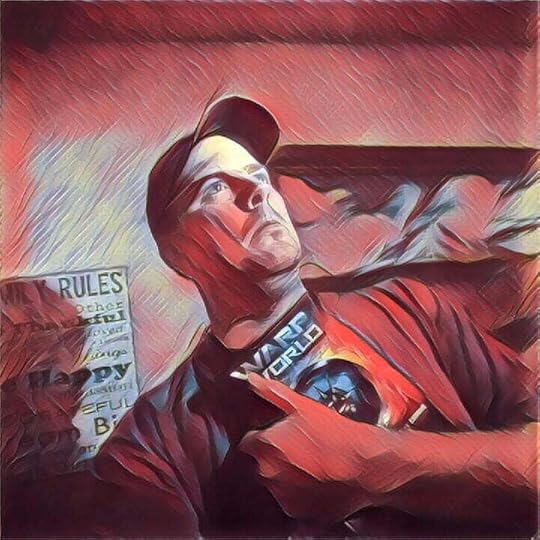 Some readers took the book more seriously than others!
Some readers took the book more seriously than others!  We love your dedication, Carl!
We love your dedication, Carl!Josh: Well, thank you. For everybody who’s ever read it, commented on it, wrote a review, asked questions, for basically any and all engagement with the series, I thank you.
I am ready to move along, I love the worldand I love the characters we’ve created, but I’ve also lived with them andtheir struggles for the better part of a decade. One thing I wanted for certainat the end of this series was a fairly definitive ending. Yes, the survivingcharacters will have other adventures, but the arc of the Warpworld series—fromSeg Eraranat arriving on S’ora and meeting Amadahy Kalder and the two of themgoing on adventures together—that story has been told.
 The infamous Guild insignia
The infamous Guild insigniaA memory that sticksout, which is funny for how little I knew at the time, was finishing the firstdraft of the fifth manuscript. We hadn’t even published the first book by thatpoint, but I remember when I wrote the final line, then I wrote “THE”, and youwrote “END”.
It’s a funny memory because it felt like that really was an ending, rather thanjust one piece of a much, much longer journey. Heck, I think we were two, twoand a half years in at that point. We were nowhere near THE END back then.
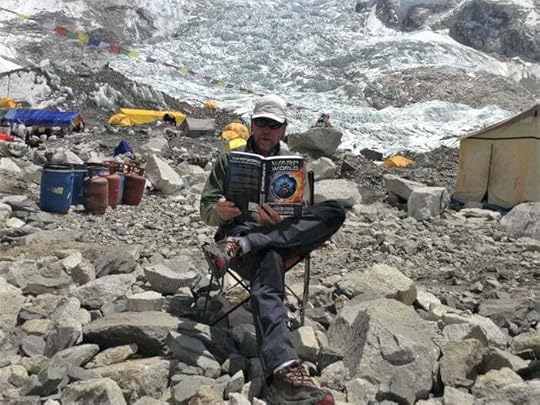 That time Warpworld was read at Mount Everest base camp! Thanks, Tim & Becky Rippel of Peak Freak Adventures!
That time Warpworld was read at Mount Everest base camp! Thanks, Tim & Becky Rippel of Peak Freak Adventures!Now, yeah, it’s here.And whatever happens from here, there’s going to be five books up on the shelfin the den with our names on them that, for the moment, will represent the sumtotal of our collaborative writing effort. When my proof copy gets in nextweek, it’s going to be a real pleasure to put that fifth book up there after Ilook it over.
Kris: I never get tired of opening up the box and seeing that proof copy for the first time! As for my memories, there are so many. One of the great things about co-authoring is that it’s not so lonely as writing by yourself. We’ve had some fabulous discussions over the years and so many laughs playing with our characters. I recall the time we imagined all our characters at a Thanksgiving dinner together and wrote out their dialogue. I could not stop laughing. Also, the intensity we brought to our first drafts. There’s a scene from, I guess it would have been the fourth book, where Seg and Ama argue and actually go their separate ways. That storyline, sadly, had to be cut, but at the time it got both of us riled up. It was the first time I wrote anything that affected me so physically.
Josh: Ah, yes, the separation scene. I remember that vividly. When you work with somebody the way we have, you get very good at interpreting their mood from their text-based commentary. When I wrote the gut-wrencher on that piece, I could tell you were about to break down in tears.
 The final paragraph of the deleted “separation scene”. It wasn’t just Ama who cried.
The final paragraph of the deleted “separation scene”. It wasn’t just Ama who cried. Heck, it’s a goodthree or four years later and I still kind of had to stop and think about howto word this, because that was probably hands-down the hardest scene we everwrote. In rewrite, it became one of those “kill your darlings” pieces becauseit didn’t fit, but maaaaaan.
Kris: Word. And I just realized that in all my acknowledgements I’ve never thanked my friend Shawn Smart Longino for their much-appreciated assistance in giving our website and blog such an awesome makeover and always helping me out when something goes wrong with the blog or the site and I start freaking out. THANK YOU, SHAWN!!! *standing ovation*
 Warpworld even made it onto the set of Godzilla in 2013! Thanks Santino (L) and Rob (R)
Warpworld even made it onto the set of Godzilla in 2013! Thanks Santino (L) and Rob (R)To close out, I mustalso give the world’s biggest shout out to all our readers and everyone who hasever helped us in any way, big or small. It was a tough decision for me to gothe indie route because it meant giving up that all-important peer validationthat I prize so highly (teacher’s pet, that I am) but, I’ll tell you what,emails or messages or the occasional hand written letter (!) from someone wholoved the story so much that they needed to tell us about it, that’s pure gold.I became a writer to share stories with people and it’s been one hell of apleasure sharing Seg and Ama’s saga with the world.
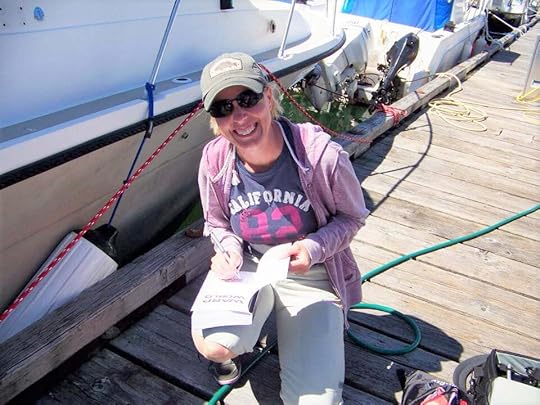 Somehow it seemed appropriate to sign a book for a fan on a dock!
Somehow it seemed appropriate to sign a book for a fan on a dock! Josh: Thank you again for sharing in our world. Don’t worry, we will be back.
Kris: We will! And now we’ll wrap up–or “warp” as Josh and I say–and let you enjoy THE…
Josh: …END

January 17, 2019
Warpworld V: Forbidden Revelations is here!
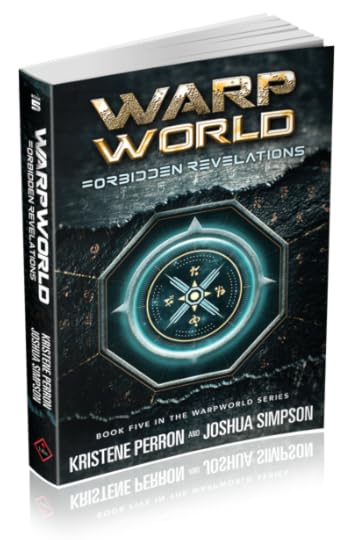
A mysterious realm where thoughts can kill, an ancient race ofdimensional travelers wiped from history, a deadly secret responsible for thedeath of worlds, and the return of a primal enemy…
At last, the answer to the question, “When will the final Warpworld book be out?” is…NOW! This one was more than a labour of love, it was a labour of sweat, tears, and some choice curse words. Very choice. But we’re excited to give you the final chapter in Seg and Ama’s story and we hope you’ll be excited too, and maybe a little surprised.
We have some celebrations planned to go out with a bang. Starting on January 17th, we’ll be running our final blog series here on the Warpworld Comms. We’ll kick off with a conversation between Josh and I, looking back on the series, with some behind-the-scenes stories and photos. Then, we’ve invited a few guests to come and talk about those two little words that can change us forever: “The End”.
You’ll meet a bestselling author whose debilitating illness opened an unexpected creative window; a Game Master whose first campaign ending was truly magical; a sister who discovered a hidden side to her brother after his death; and an author who has some advice for writers grieving over the end of a writing project.
We’ll also have a few surprise treats and giveaways, so keep tuning in here or on our Facebook page.
Thanks for sticking with us! Here’s to The End!
August 18, 2017
You Are Invited To: A Pity Party!
Date: Right now and for weeks to come
Place: In Kristene and Josh’s brains
Theme: Working on the second draft of the final book of the Warpworld series, which has to be AMAZING and answer a lot of questions and also be entertaining and…oh good gravy, what have we done to ourselves??? *cries*
Dress: Casual. Like, we mean, why even bother getting out of your pajamas since you’re going to be in front of your computer screen all day–that’s how casual.
Food: Whatever can be eaten with no preparation eg. sunflower seeds, last night’s pizza, something you spilled on your shirt two days ago.
Drink: Tears.
In lieu of gifts, the authors ask for your continued patience and pity.
And while you’re waiting for this book to be finished, here’s a cute video of a baby sea otter.
March 1, 2017
Kristene Goes to the Creative Ink Festival – Vol. 3
Holy karg! Is it March already?
Josh and I have been so busy outlining and starting the first draft of the fifth and final book of the series (which is going to blow your mind, just FYI), that the months have been flying by.
The good news is that March means the annual Creative Ink Festival is right around the corner! WOO HOO! Once again, I will be journeying across the ocean to attend, to volunteer, and to speak on some crazy-good panels. (It’s only an hour-and-a-half ferry ride but that sounds adventurous, doesn’t it?)
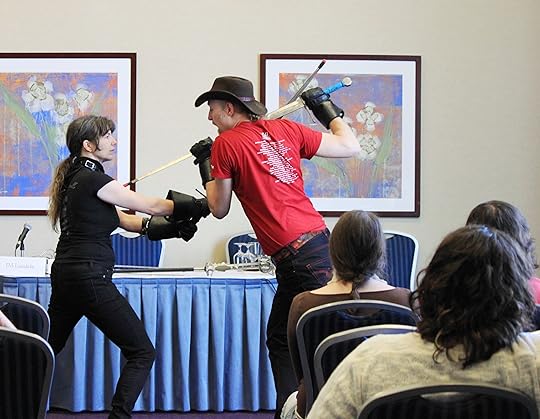
Action from the 2016 Creative Ink Festival. JM Landels (L) and Devon Boorman (R) demonstrate sword fighting techniques
This year’s CIF promises to be full of the usual mind-expanding fun but with a super perk for one lucky festival goer. Josh and I have teamed up with Super Ninja Festival Organizer Sandra Wickham to offer a shiny new Kindle Paperwhite as a prize! And it gets better because the Kindle will come loaded with a Creative Ink Festival library of books donated by authors and publishers! Nifty, right?
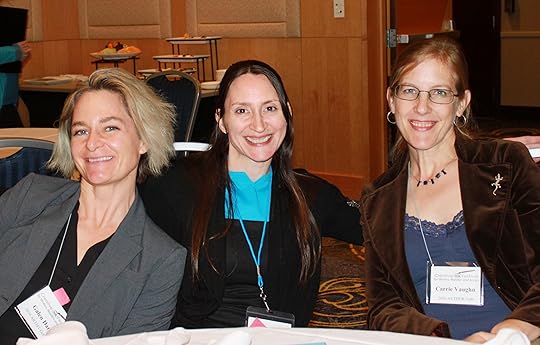
(From L to R) Artist GoH Galen Dara, festival organizer Sandra Wickham, and Author GoH Carrie Vaughn at the 2016 Creative Ink Festival.
Check out the Creative Ink Festival Facebook page for more updates and for your chance to enter!
As for me, when I’m not taking photos or taking notes, I’ll be speaking or moderating on panels including the Real Life Super Women presentation (don’t miss it!) and the always-ridiculous and occasionally hilarious improv storytelling panel Storytelling On The Fly.
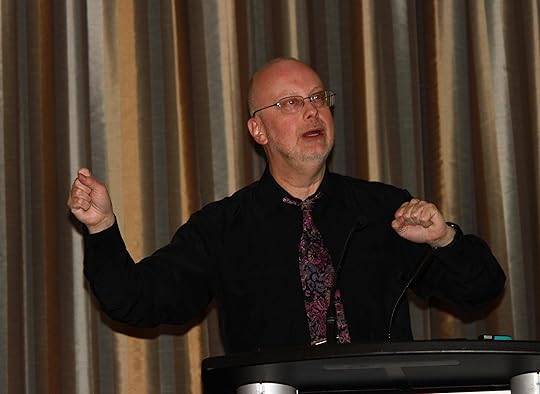
Robert J Sawyer’s inspiring keynote speech at the 2016 Creative Ink Festival Banquet
So here’s where to find me this year…
Friday, March 31
2pm – Designing Character Backgrounds
JP (Jo-Anne) McLean (M), Adam Dreece, Kristene Perron, Mel Anastasiou, Tom D Wright
You have an idea for a character, now you have to figure out how to flesh out the character. Come listen to our panelists discuss how to do this.
Saturday, April 1
9am – Creating Tension
Mel Anastasiou (M), Kristene Perron, Mark Teppo, Randy McCharles, Trevor Melanson
Top Agent Donald Maass says there should be tension on every page. How do we accomplish that? How do we get our readers hooked on the anticipation of what will happen next? How do we keep them invested in what happens to our characters? What happens in our world of the novel?
1pm – Real Life Superwomen
Lisa Gemino, Sandra Wickham, JM Landels, Kristene Perron
What do you get when you put an MMA fighter, a pro fitness competitor, a mounted combat expert and a stuntwoman together on one panel? A rousing discussion about the realities of being a “strong woman” and how that compares with their portrayal in fiction. Join authors Lisa Gemino, Sandra Wickham, JM Landels, and Kristene Perron as they KAPOW the stereotypes and share the truth about the lives of superwomen.
6pm – Storytelling on the Fly
Krista Wallace (M), Brenda Carre, Colleen Anderson, Kristene Perron, Mark Teppo
Writers know that nasty little editorial voice that wants to control every idea, every sentence, every word. Come and share some laughs with these writers as they send that nasty voice away kicking and screaming. With only a few prompts, they will create a story together, one sentence at a time. It WILL have a beginning, middle and an end. It WILL NOT make much sense. There WILL be mirth.
Sunday April 2
11am-How to Create A Writing Routine (and stick with it)
Donna Barker (M), JP (Jo-Anne) McLean, Kristene Perron, Samantha Beiko, Tyner Gillies
Do you find yourself procrastinating your writing? Having a hard time getting into a groove of writing consistently? What are the best ways to create a writing routine and to keep it going?
12pm – How to Kill Characters
Kristene Perron (M), Lisa Gemino, Trevor Melanson, Tom Wright
Killing off characters may be a skill George RR Martin has perfected, but how do you do it effectively? Are there wrong times or reasons to kill off a character? What are the right reasons? How do you make it have an impact on the reader? How do you write an effective death scene? We don’t have George, but we have a panel of pros to help answer all these questions!
1pm – Raise the Stakes
Kristene Perron (M), Mel Anastasiou, Danika Dinsmore, TG Shepherd, Tom Wright
Writers are always told to “raise the stakes!” in their stories. How do you do that successfully, without it seeming contrived? What makes for high stakes that work for the character and for the reader?
The Creative Ink Festival for writers, readers and artists will be held March 31 – April 2, 2017 at the Delta Burnaby Hotel and Conference Center, in Burnaby, BC. You can find more information at: www.creativeinkfestival.com
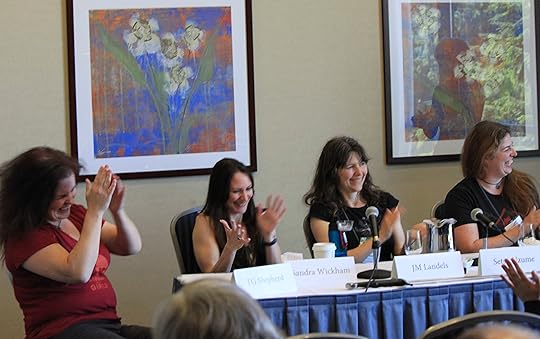
Lots of laughs on the Real Life Superwomen Panel, CIF 2016. (L to R) Lisa Gemino, Sandra Wickham, JM Landels, Setsu Uzume
You can join the CIF Facebook Group here: www.facebook.com/groups/909897895708908/
…or follow CIF on Twitter at: @creativeinkfest
And if you plan on attending (you ARE going to attend, right??) make sure you come up to me and say hello–I’ll be the one with the goofy grin and the martini!
Blood for water
~Kristene
Thanks for visiting the Warpworld Comm! Contact us for infrequent, non-spammy, and highly entertaining Warpworld news.
October 12, 2016
Super Duper Quadruple Giveaway!

Yes, it’s Goodreads giveaway time again. This time we are giving away a copy of each book in the series so far–that’s 4/5ths of the Warpworld Saga up for grabs! All you need to do to enter is warp on over to Goodreads. Here are the links for all four giveaways…
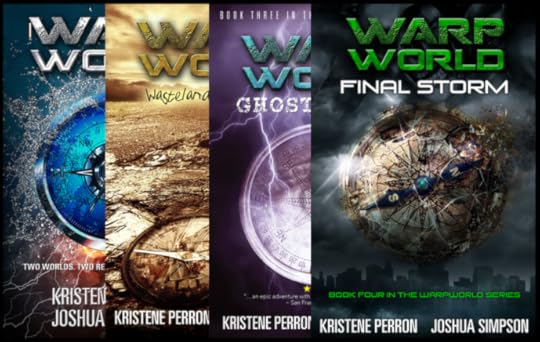
Entry is free but we sure hope if you win you’ll rate or review your book for us on Goodreads and/or Amazon! We loooooooooove reviews!!
Oh, and don’t forget that Warpworld Vol. 1 is now perma-free for ebook lovers. You don’t even need to win anything.
Kargin’ awesome, ol?
Blood for water
~Kristene
Thanks for visiting the Warpworld Comm! Contact us for infrequent, non-spammy, and highly entertaining Warpworld news.



